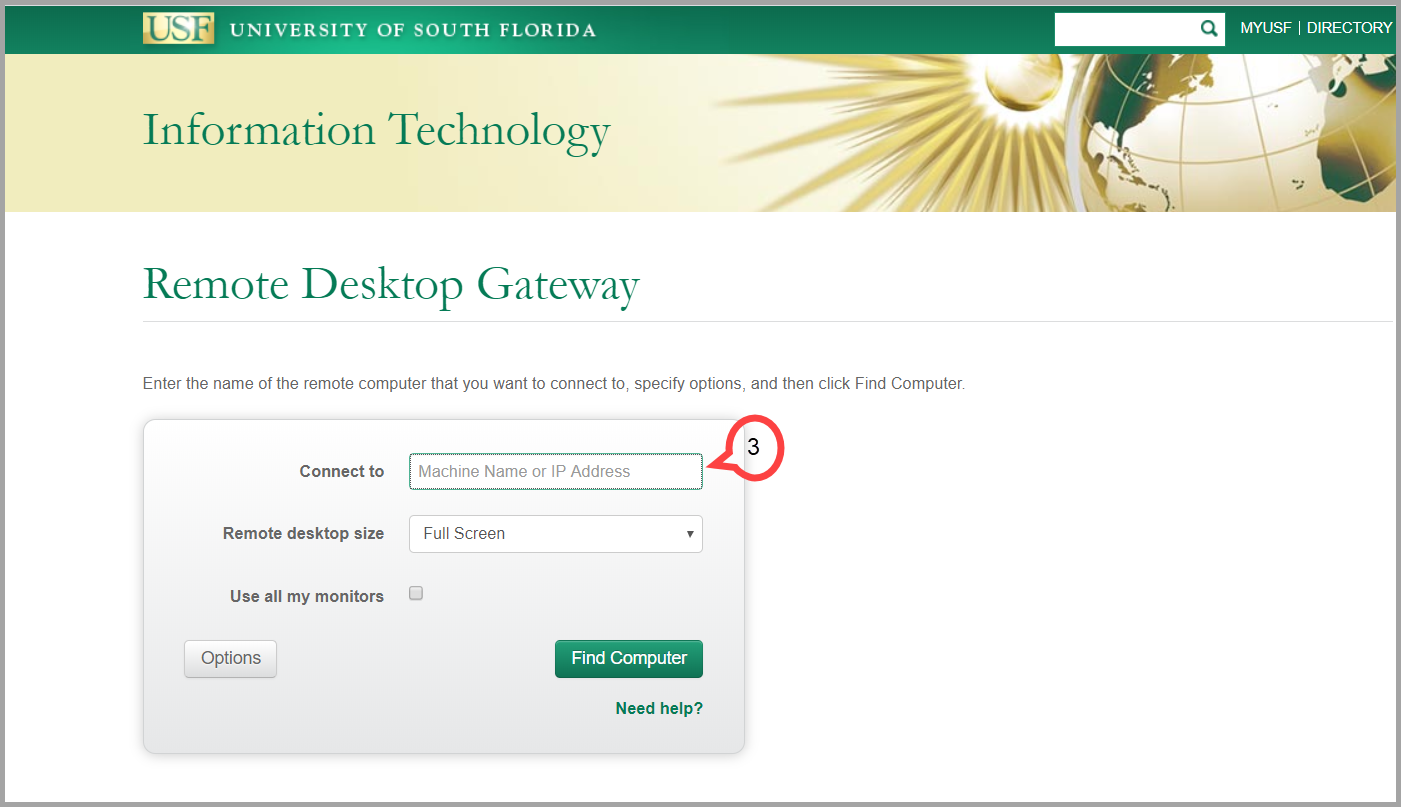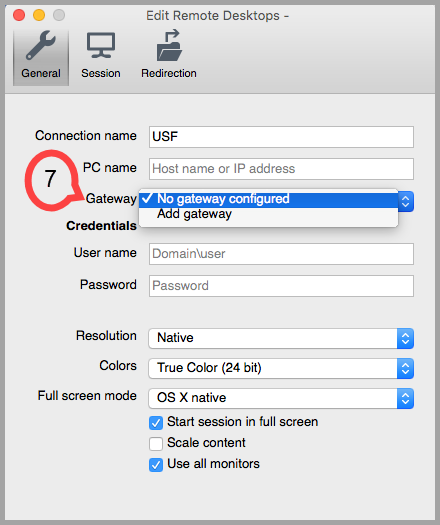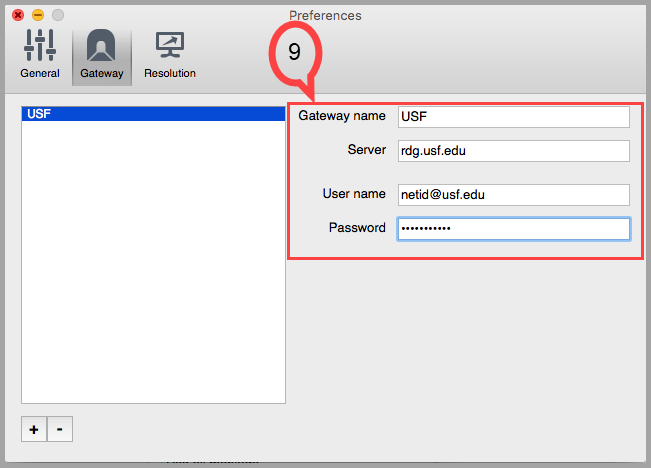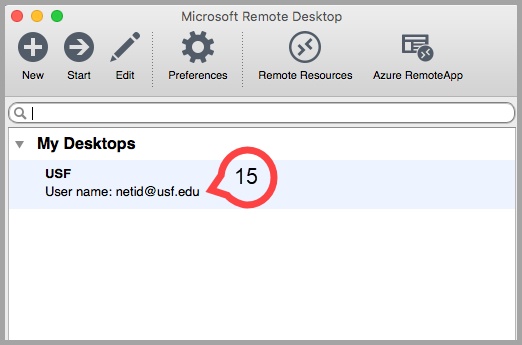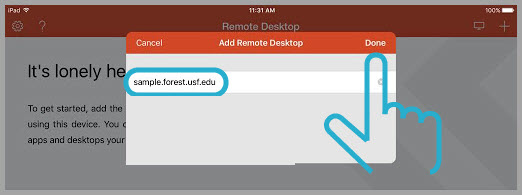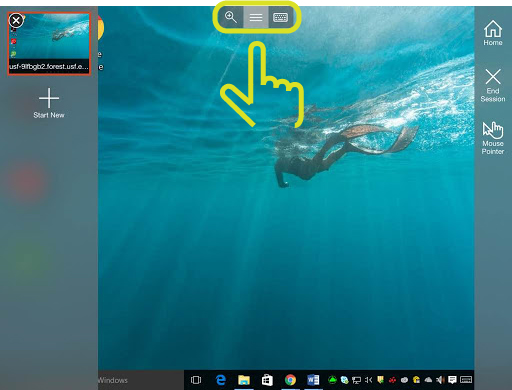Overview
The Remote Desktop Gateway (RDG) is used to access your on-campus Windows computer from another remote computer. It provides additional security for our connections with university computing resources.
The following directions are meant to assist in setting up an RDG connection on your own.
If you have any trouble or wish to have USF IT configure your remote connection for you, please visit https://www.usf.edu/it/about-us/helpdesk.aspx - macOS and Windows 7 users must contact USF IT, via itchat.usf.edu, for configuration
Requirements and Setup of USF Office Computer
Checking your user group
Your account must be in the destination computer’s Administrators and Remote Desktop Users groups.
- Hit the Windows key on your keyboard (Note: on Windows 10 click on the circle icon next to the Windows icon on your task bar)
- Type lusrmgr.msc into the search bar
- Hit the Enter key on your keyboard
- Click on the Groups folder on the left
- Double click on Administrators in the center column (pictured below)
A new window should pop up - Look for you NetID in the pop up
- Double click Remote Desktop Users in the center column (pictured below)
A new window should pop up - Look for your NetID in the pop up
Found your NetID under Administrators and Remote Desktop Users? Continue to Remote Desktop Access Instructions#Finding your computer's name.
Newly Deployed Machines
If you have a newly deployed machine (later then January 2022), you will need to add yourself to the Remote Desktop Users manually by doing the following
- Click on the Windows Start button in the lower left
- Type CMD and right-click Command Prompt and select Run as Administrator.
- Select Yes on the windows prompt
Enter the following:
- Net localgroup “Remote Desktop Users” /add “AzureAD\<NetID>@usf.edu"
Note: Make sure you replace <NetID> with your NetID
- Net localgroup “Remote Desktop Users” /add “AzureAD\<NetID>@usf.edu"
- Hit Enter once the above is entered into the command prompt.
- If successful, you should receive a message that the user has been added.
Can't find your NetID under either Administrators or Remote Desktop Users? Contact us at 813-974-HELP(4357) or itchat.usf.edu
Finding your computer's name
You will need to know the computer’s name.
In Windows 10:
- Click on the circle icon, next to the Windows icon, on your taskbar
- Type computer name into the search bar
- Hit the Enter key on your keyboard
- The name is displayed in the Device name field
Connecting from a Remote Computer
If you are using a Mac or Window 7 machine from home to connect to your newly deployed PC on campus, you must contact USF IT Remote Support to have an edit made to your work system.
This must be done on campus while logged into the newly deployed machine.
Please call 813-974-4357 or visit itchat.usf.edu to have this work done for you.
- Make sure your browser (Chrome, Firefox, Microsoft Edge) is the most recent version.
- The computer you are logging in remotely from must have an up-to-date version of Microsoft's Remote Desktop Connection.
- Macs with OSX 10.7 or later can get this app from the App Store, see the Mac instructions below.
If remoting into a recently deployed device using IT's Modern Endpoint Management, you will need to first log into VPN.usf.edu
Windows
- Go to http://usfweb.usf.edu/remote/
- Login with your NetID@usf.edu and password
- Enter the computer name or IP address you wish to connect to (pictured below)
- Choose your remote desktop size
- Click the Find Computer button
RDG will go through a series of checks (computer is found, awake, and connection is solid) and display the results to you - Click the Connect button
RDG will download a ‘USFRemoteAccess.rdp’ file Execute USFRemoteAccess.rdp file
Security window popped up? Click ConnectLog in with your credentials
You are logging into your destination computerIf remoting into a new, recently deployed device, you must log in using AzureAD\<Netid>@usf.edu for your user name.
Note: Make sure you replace <NetID> with your NetID
Once you have completed this process, you will have a window to your destination computer and may use it as if you were sitting in front of it. When you are finished, you can simply log out of your remote computer and the window will close.
Mac
If you are using a Mac from home to connect to your newly deployed PC on campus, you must contact USF IT Remote Support to have an edit made to your work system.
This must be done on campus while logged into the newly deployed machine.
Please call 813-974-4357 or visit itchat.usf.edu to have this work done for you.
- Launch the App Store
- Search for the Microsoft Remote Desktop
- Click on Microsoft Remote Desktop
- Enter your credentials for your Apple account
- Launch Microsoft Remote Desktop
- Click on New in the upper left
- Choose Add gateway from the Gateway drop down menu (pictured below)
- Click on the Plus sign to add a gateway:
- Fill out the following fields (Pictured below)
- Gateway Name = USF
Server = rdg.usf.edu
User name = Your USF email or for newly deployed machines, you must log in using AzureAD\<Netid>@usf.edu for your user name.
Note: Make sure you replace <NetID> with your NetID- Password = Your NetID password
- Close the Preferences screen
- Choose USF from the Gateway drop down menu
- Enter your email address and password under Credentials
- Enter your computer name in the PC Name field
- Close out of the Edit Remote Desktops screen
- Click on USF under My Desktops (pictured below)
- Click on Continue
You will be connected
IPad
- Tap on the App Store
- Search Microsoft Remote Desktop
- Tap on Get
- Tap on Install
- Open the Microsoft Remote Desktop app
- Tap the Plus sign (pictured below)
- Tap Desktop
- Tap PC Name
- Enter your computer's name (pictured below)
- Tap Done
- Tap the panel on the Remote Desktop main menu
Enter the credential you use on your machine
Tapping the controls at the top will allow you to zoom, switch between mouse pointer and touch functionality, bring up a keyboard, etc



